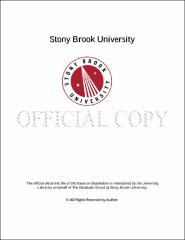| dc.identifier.uri | http://hdl.handle.net/11401/76204 | |
| dc.description.sponsorship | This work is sponsored by the Stony Brook University Graduate School in compliance with the requirements for completion of degree. | en_US |
| dc.format | Monograph | |
| dc.format.medium | Electronic Resource | en_US |
| dc.language.iso | en_US | |
| dc.publisher | The Graduate School, Stony Brook University: Stony Brook, NY. | |
| dc.type | Thesis | |
| dcterms.abstract | The Forge River on the south shore of Long Island is contaminated by nitrate. The Forge River leads into Moriches Bay. Nitrate contamination in the river leads to algal blooms, hypoxia of the river and eventually fish kills. The area surrounding the Forge River is largely residential and not sewered with the residents relying on septic systems for sewage disposal. Nitrate from even small septic systems has been found in groundwater as far as 100m down gradient. Other investigators have shown the occurrence of submarine groundwater discharge on Wills Creek, a tributary of the Forge River and my study site. I hypothesized that much of the nitrate contamination was flowing into the river from the surrounding groundwater. In order to remediate the groundwater before it reached the river, the study looked at whether this location would be a suitable location for a permeable reactive barrier. Monitoring wells were installed in April and June and sampled over the months of June and July of 2014. Groundwater analysis included nitrate-nitrite, ammonium, total nitrogen and total organic carbon. Dissolved oxygen concentrations were below 4.08 mg/L in all of the installed wells. Conductivity was less than 1.37 mS/cm in each well proving that the wells were in fresh groundwater. Nitrate-nitrite ranged from 0.46 mg/L to 22.95 mg/L. Samples with lower dissolved oxygen concentrations seemed to have a higher nitrate-nitrite concentration. Ammonium concentrations ranged up to 19.56 mg/L. Ammonium was highest in the monitoring well that also had the highest nitrate-nitrite concentrations. Evidence was found for three potential contaminant plumes. Two were at the water-table apparently leading out from the individual septic systems and one was deeper and apparently more widespread. The hydraulic conductivity of a permeable reactive barrier would need to be over 8.2 m/d congruent with the Upper Glacial Aquifer. I concluded that a permeable reactive barrier could work to denitrify groundwater at the Wills Creek study site, provided that it was engineered to allow the correct residence time to occur for denitrification. | |
| dcterms.available | 2017-09-20T16:49:39Z | |
| dcterms.contributor | Bokuniewicz, Henry J | en_US |
| dcterms.contributor | Swanson, R | en_US |
| dcterms.contributor | Roethel, Frank. | en_US |
| dcterms.creator | Pritt, Amy Bronwan | |
| dcterms.dateAccepted | 2017-09-20T16:49:39Z | |
| dcterms.dateSubmitted | 2017-09-20T16:49:39Z | |
| dcterms.description | Department of Marine and Atmospheric Science. | en_US |
| dcterms.extent | 59 pg. | en_US |
| dcterms.format | Monograph | |
| dcterms.format | Application/PDF | en_US |
| dcterms.identifier | http://hdl.handle.net/11401/76204 | |
| dcterms.issued | 2015-12-01 | |
| dcterms.language | en_US | |
| dcterms.provenance | Made available in DSpace on 2017-09-20T16:49:39Z (GMT). No. of bitstreams: 1
Pritt_grad.sunysb_0771M_12293.pdf: 2652121 bytes, checksum: 3fccf601dceee5e5efb46e693615c1dc (MD5)
Previous issue date: 1 | en |
| dcterms.publisher | The Graduate School, Stony Brook University: Stony Brook, NY. | |
| dcterms.subject | Marine geology | |
| dcterms.title | Groundwater nitrate contamination remediation through permeable reactive barriers on the Forge River, Long Island, New York | |
| dcterms.type | Thesis | |

